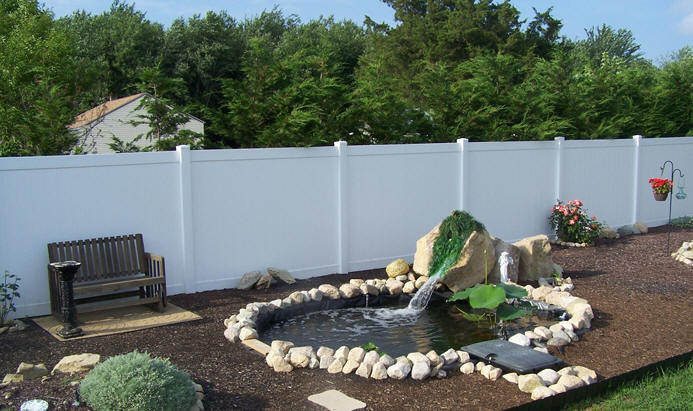 CONSTRUCTION KNOWLEDGE >>
SITE WORK >>
CONSTRUCTION KNOWLEDGE >>
SITE WORK >>
LANDSCAPING
1. What Should I Know about Landscaping, Seeding and Mulching?
1.1 What Should I Know about Fences and Decks?
2. What Public Domain Documents are Available for Further
Study?
3. Tricks of the Trade & Rules of Thumb
for Landscaping:
What Should I Know about Landscaping, Seeding and Mulching?
Landscaping is a finishing touch on a project. It's amazing how a well designed landscape plan can transform a dull building into an exciting piece of property. The landscape plan, provided by a Landscape Architect, should show the details for the work to be performed. If the work proceeding the landscape work (i.e. excavation and embankment, layout, final grading, topsoiling) was done correctly, the landscaping should go smoothly. In this situation, the amount of input, and attention, required by the Construction Supervisor is minimal at the landscaping stage. Do the planning work at the beginning and the finishes go well.
One landscaping item that must be planned in the earliest stages of a project is the topsoil. How it is stripped and where it is stored are important questions, as it's the first item in a pile and the last to be spread. You will live with that pile for the whole project, so be sure to approve its location.
I once had an old equipment operator show me a trick with topsoil that proved very useful. Our topsoil stripping produced a pile of mucky, organic topsoil that would not cover half of the required area when replaced. In times when he wasn't real busy this fellow would take his track loader and mix a bucket of sandy soil and a bucket of clay soil with this topsoil. As our topsoil pile grew, the quality of the topsoil improved also. By understanding the requirements for topsoil and making use of otherwise lost time, that operator saved the earthwork contractor a significant amount of money and provided totally acceptable topsoil. There are plenty of people with creative solutions that only need to be heard.
The preparation of the seed bed for planting lawns is normally covered in the Specifications. Typically a minimal topsoil depth is given along with instructions on disking and smoothing. Lime and fertilizer complete the seedbed preparation. The seeding itself can be hand spread with a seeder, mixed with water and hydro-seeded, or drilled into the soil with farm equipment. The Landscape Contractor will determine which of these methods are appropriate for the project. Mulching should follow immediately after seeding. Mulch protects the bare topsoil from erosion, conserves water and controls temperature prior to the seed growth. Chopped straw is a common mulch that can be mechanically dented into the soil with farm equipment or tacked with a spayed asphalt to avoid blowing. Fiber mulch can also be used with a hydro-seeding machine.
Sodding may be required on a project to give the grounds a finished appearance or to reduce erosion. The primary rule of sodding involves placing the brown side down and the green side up. If the sod doesn't have a green side, there's a problem. Sod is easily harmed by a lack of water both before and after installation. The Construction Supervisor should be sure that the responsibility for watering is clear, as the party that waters should also be responsible to replace dead sod. The tasks of mowing, weeding and spraying should also be clearly delineated.
The planting of shrubs and trees is often the last landscape work. The landscape contractor must arrange delivery and temporarily store and protect the plants. The Design Professional also specifies the allowable planting season. The Construction Supervisor should consider these dates in project scheduling. .
What Should I Know about Fences and Decks?
The many fence manufacturers provide info on their respective products, but the ebook above provides a framework for deciding which product will best solve the real design problems.
Since fences are often an after-thought on construction projects, keep this little ebook as a way to help an owner make a better design decision. Remember, as we help our customers truly succeed, our success follows.
What Public Domain Documents are Available for Further Study?
An excellent resource for learning the basics of landscape
design, planting and turf grass is from the US Dept of Defense and
titled
Landscape Design and Planting Criteria. It has
63 pages
of information and the official name of this document is UFC
3-210-05FA 16 January 2004.
Tricks of the Trade & Rules of Thumb for
Landscaping:
- When placing sod, make sure the brown side goes down and the green side up, key to remember, then, is "Brown side down".
- Consider allowable planting dates for seeding and
landscaping when creating the project schedule.


